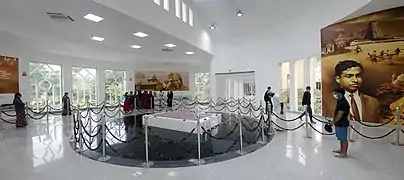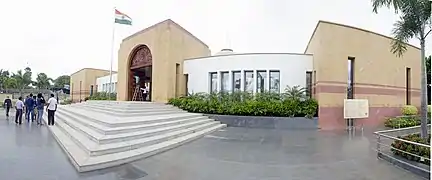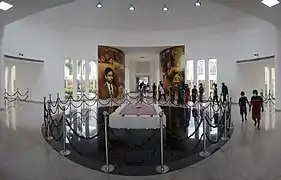 Kalam's Mausoleum | |
| Location | Rameswaram, Tamil Nadu, India |
|---|---|
| Designer | Central Public Works Department Defence Research and Development Organisation[2] |
| Type | Mughal architecture Ancient Indian architecture |
| Material | Cement, Iron, marble, and granite |
| Opening date | 22 July 2017 |
| Dedicated to | A. P. J. Abdul Kalam |
The "Dr. A. P. J. Abdul Kalam National Memorial" is a mausoleum in memory of A. P. J. Abdul Kalam (1931–2015), the 11th President of India (2002-2007), located in his home town, Rameswaram, Tamil Nadu, India. The memorial was designed and constructed by Defence Research and Development Organisation (DRDO) as a tribute to Kalam and to display the cultural heritage and ethnic diversity of India. It was officially inaugurated by Prime Minister Narendra Modi in July 2017. A symbol of national integration, the memorial is an amalgamation of Mughal and Indian architecture.
Background
Kalam died on 27 July 2015, Kalam travelled to Shillong to deliver a lecture on "Creating a Livable Planet Earth" at the Indian Institute of Management Shillong. The lecture was supposed to be 4000 words, but only after speaking the initial two sentences, Kalam collapsed and he was confirmed dead of a sudden cardiac arrest later at a hospital.[3] Kalam's body was airlifted in an Indian Air Force helicopter from Shillong to Guwahati, from where it was flown to New Delhi on the morning of 28 July.[4]
Following Kalam's death, the Indian Minister of Home Affairs called an emergency meeting of the Union Council of Ministers, attended by Prime Minister of India Narendra Modi. In the meeting, a proposal to build the "Dr. A. P. J. Abdul Kalam National Memorial" was finalised. The Indian Government proposed to perform Kalam's funeral service at Raj Ghat-(Ekta Sthal) in New Delhi, and build a memorial there. Kalam's family objected, since Kalam had wanted to be buried in his hometown, Rameshwaram, and the Indian government agreed to go along with the family's wishes,[5][6] and in the same year on Kalam's birth date which is on 15 October, the commencement of construction on a memorial at Rameshwaram was publicized by Prime Minister Narendra Modi.[7] On 27 July 2017, on the occasion of Kalam's second death anniversary, the memorial was inaugurated by Prime Minister Narendra Modi.[8][9]
Structure, architecture, and landscape
The Defence Research and Development Organisation (DRDO) initiate to design and building of the memorial,[10] and in December 2015 the construction was started. In July 2016 Defence Minister Manohar Parrikar officially laid the foundation stone on the occasion of the first anniversary of Kalam's death. The construction was completed within one year,[8][9] with the engagement of 500 workers,[11] and sometimes the work was carried out around the clock. The work was supervised by DRDO's chief construction engineers; Colonel B. Choubey and Colonel B. K Singh.[10]
The memorial covers 2.11 acres of land, the built-up area is 1,425 square meters,[8][9] and the construction cost up to 1.2 ₹ billion.[12] The mausoleum is built of granite, marble and reinforced concrete.[10][13][14][11] The construction material was sourced from different parts of India and transported to the construction site; the stone columns are sourced from Bangalore, the stone cladding was designed in Jaisalmer and Agra, wher as the main entrance wooden doors are crafted in Thanjavur and the marble was brought from Karnataka.[11][15]
With an amalgamation of Mughal and Indian architecture, the memorial is designed in a way to display the cultural heritage and ethnic diversity of India, making it a symbol of national integration.[16][17][12] There are three entrances to the structure,[11] of which the main entrance doorway resembles the India Gate of Delhi, while it's hallway resembles the Brihadisvara Temple, of Thanjavur, and the wooden doors are designed in Chettinad style. At the northern end of the memorial lies a circular sepulchre that houses Kalam's grave. The main dome resembles one of Rashtrapati Bhavan's central domes and houses a bronze statue of Kalam playing the Veena.[18][19] The central dome is connected to four display halls of about 2500 square feet—(each hall depicts Kalm's life in phases, and they are designed as children's square, scientist square, motivation square, and lecture square),[11] that house replicas of rockets and missiles, 900 paintings; that include,[18][20][7] murals (sourced from Hyderabad, Shanti Niketan, Kolkata and Chennai),[11] Shekhawati paintings, a collection of 200 photographs that highlight his long association with the DRDO, the Indian Space Research Organisation (ISRO), and his involvement with India's civilian space program and military missile development efforts. There are paintings and life-sized sculptures that illustrate Kalam at different ages. A 45-foot tall replica of the Agni missile with a theme of "unity in diversity" is displayed at the forefront of the structure. The memorial features quotes from Kalam as a scientist and the president of India.[18][20]
The outer precinct around the memorial consists of landscaping, with the plantings sourced from neighboring states of Andhra Pradesh, Karnataka, and Telangana. The landscape is designed in the Mughal garden style, with pergola pathways lined with models of missiles designed by Kalam.[10][12][13][19]
Gallery
- Pictures of Kalams memorial
 Tomb of Kalam.
Tomb of Kalam. Exterior of Mausoleum.
Exterior of Mausoleum. Four display halls connecting to the Central Tomb.
Four display halls connecting to the Central Tomb. Grave of Kalam.
Grave of Kalam. Distant view of Mausoleum.
Distant view of Mausoleum.
References
- ↑ "Official Name as given by Press Information Bureau, Government of India". Archived from the original on 23 October 2016.
- ↑ K, Smitha. T (30 December 2015). "Construction of Memorial To President Kalam Begins". NDTV. Retrieved 7 April 2022.
- ↑ "Remembering Dr APJ Abdul Kalam's last lecture on his 5th death anniversary". The Free Press Journal. 27 July 2020. Retrieved 6 September 2022.
- ↑ "Farewell Kalam! Pranab, Modi lead nation in paying homage". Hindustan Times. 28 July 2015. Retrieved 6 September 2022.
- ↑ Tripathi, Rahul (29 July 2015). "APJ Abdul Kalam's funeral & memorial to be in his hometown Rameshwaram". The Economic Times. Retrieved 29 July 2022.
- ↑ "Dr. APJ Abdul Kalam's Memorial". Ramanathapuram District. 20 July 2022. Retrieved 1 August 2022.
- 1 2 "PM inaugurates memorial of former President Dr. A.P.J. Abdul Kalam". DD News. 27 July 2017. Retrieved 6 September 2022.
- 1 2 3 "What is the Abdul Kalam memorial row?". The Indian Express. 31 July 2017. Archived from the original on 8 August 2018. Retrieved 7 April 2022.
- 1 2 3 Kaur, Savneet (2022). The address Great Scientists of the World : APJ Abdul Kalam. Diamond Pocket Books Pvt Ltd. pp. 1–96. ISBN 9789355994127. Retrieved 1 August 2022.
- 1 2 3 4 Scott, D.J. Walter (12 July 2017). "Finishing touches being given to Kalam memorial". The Hindu. Retrieved 1 August 2022.
- 1 2 3 4 5 6 M, Anantha Krishnan (26 July 2017). "All spruced up for Kalam Memorial inauguration". Mathrubhumi News. Retrieved 6 September 2022.
- 1 2 3 "APJ Abdul Kalam Memorial inaugurated by PM Narendra Modi, here are top 10 things to know". Financial Express. 27 July 2017. Retrieved 1 August 2022.
- 1 2 "Kalam memorial emerges as major tourist attraction". The Hindu. 24 December 2017. Retrieved 1 August 2022.
- ↑ Nath, Akshaya (27 July 2017). "APJ Abdul Kalam memorial in Rameswaram: All you need to know". Retrieved 1 August 2022.
- ↑ "PM to inaugurate Dr. APJ Abdul Kalam Memorial tomorrow". Press Information Bureau. 27 July 2017. Retrieved 6 September 2022.
- ↑ "APJ Abdul Kalam Memorial – Rameswaram". Tamil Nadu Tourism. 2019. Retrieved 1 August 2022.
- ↑ "Prime Minister Narendra Modi Inaugurates APJ Abdul Kalam Memorial In His Hometown Rameswaram". architexturez.net. 27 July 2017. Retrieved 1 August 2022.
- 1 2 3 "In pictures: Finally, a memorial worthy of Abdul Kalam, a President who inspired millions". The News Minute. 27 July 2017. Retrieved 7 April 2022.
- 1 2 Datta, Rangan (27 July 2022). "Dr. A.P.J. Abdul Kalam Memorial — a fitting hometown homage to the 'people's president'". Telegraph India. Retrieved 1 August 2022.
- 1 2 "What is the Abdul Kalam memorial row?". The Indian Express. 31 July 2017. Retrieved 29 July 2022.
External links
- APJ Abdul Kalam Memorial Day: Abdul Kalam Books, Quotes, Peotry [sic], Early Life, Presidency, Memorial & Death Anniversay [sic]
- Dr.APJ Abdul Kalam Memorial In Pei Karumbu Rameshwaram